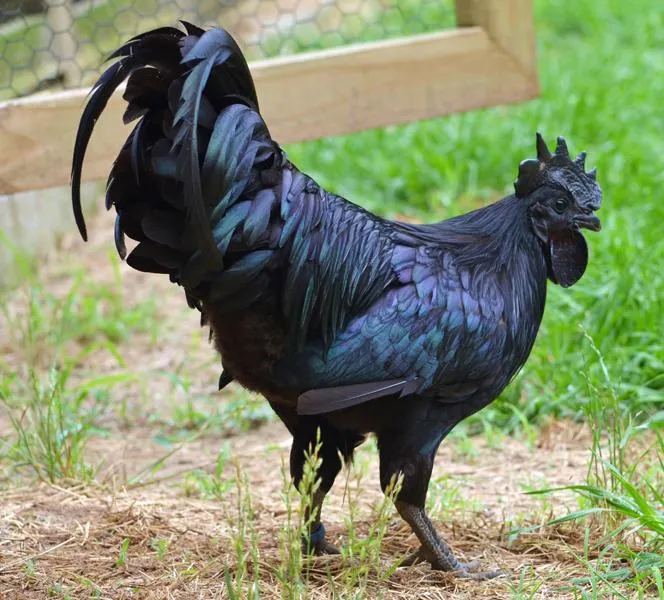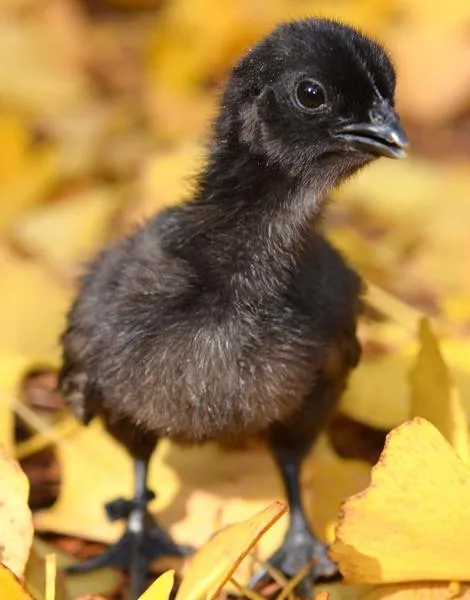These Chickens Have Jet-Black Hearts, Beaks and Bones
The Ayam Cemani owes its unusual coloring to a genetic mutation
:focal(451x176:452x177)/https://tf-cmsv2-smithsonianmag-media.s3.amazonaws.com/filer/a8/05/a80596c6-2412-497b-8f8f-e871da2fec9e/ayam-cemani-cem-046.jpg)
The Ayam Cemani—an inky black chicken breed indigenous to Indonesia—is known by many names: among others, the “world’s most bewitching chicken,” the “Lamborghini of poultry,” the “Goth chicken” and the “Sith Lord bird.”
There’s a reason this chicken commands such attention. As Jason Bittel writes for National Geographic, the Cemani is perhaps the “most deeply pigmented creature” found in nature. Every aspect of its appearance, from its feathers to its beak, tongue, eyes and claws, is jet-black.
This unusual coloring extends to the breed’s internal features, including its organs, muscles and bones; the chicken’s meat, by extension, looks as if it has been “marinated in squid ink.” Per Gizmodo’s Rae Paoletta, the exceptions to this trend are the Cemani’s blood and eggs, both of which sport more typical hues.
Cemanis are far from the world’s only black birds, but as Kat McGowan reports for Nautilus, the majority of darker-colored avians have pink tongues, brown eyes and normal-hued innards. In total, just three other chicken breeds—Sweden’s Bohuslän-Dals svarthöna, Vietnam’s Black H’Mong and the Silkie—share the Cemani’s “internal blackness,” a condition which is known in scientific parlance as fibromelanosis, or dermal hyperpigmentation. (Modern Farmer’s Laurie Woolever notes that the Silkie, a five-toed chicken whose black innards are covered by fluffy, cream-colored feathers, derives its name from the fur-like texture of its plumage.)

Leif Andersson, a geneticist at Sweden’s Uppsala University who led a 2011 study on the unusual phenomenon, tells National Geographic’s Bittel that fibromelanosis stems from a “complex rearrangement in the genome.” Crucially, Andersson adds, members of all four affected breeds can trace the mutation back to a single ancient chicken: “What is interesting is that all chickens with this phenotype carry exactly the same mutation,” he says to Nautilus’ McGowan. “It suggests that some humans saw these black birds and were excited about them, kept them, and sold them and they spread over the world.”
According to Bittel, the variation occurs in a gene called endothelin 3, or EDN3. Normally, a specific group of cells in developing chickens’ systems use EDN3 to guide the migration of color-creating melanoblasts, but in hyperpigmented breeds, almost all of the chickens’ cells express EDN3. The result, Andersson explains, is a “mis-migration” in which ten times as many melanoblasts migrate to the “wrong place.”
Cemanis are difficult to obtain in the United States, where fear of avian flu has led to a ban on direct imports from the breed’s home country of Indonesia. As Ethan Harfenist notes for Vice, the going rate for a breeding pair was $2,000 around October 2014. At the time, the chicken was in such high demand that it was featured in New York magazine’s annual gift issue. Greenfire Farms, the most well-known U.S.-based Cemani breeder, currently sells day-old chicks for $199, but the much-admired hatchlings are rarely in stock.

Speaking with Nautilus, Greenfire Farms owner Paul Bradshaw explains, “Somebody who plunks down $1,500 for a Williams-Sonoma chicken coop, they want an artisanal chicken breed. They want something special, with a story, something beautiful. That’s the market we serve.”
GlobalPost’s Patrick Winn writes that the Cemani is viewed rather differently in Java, the Indonesian island where it first emerged. Here, the chicken is lauded as a magical creature with immense healing powers. “Hardly anyone eats them,” a 22-year-old Cemani farmer named Firdaus tells Winn. “Most people are interested only in their magical blood.”
Veronika Kusumaryati, an anthropologist at Harvard University, says the breed was traditionally associated with local elites and royalty. Used in rituals as early as the 12th century, the Cemani acted as a messenger between human and supernatural realms. As Kusumaryati explains to Nautilus, Javanese lore maintains that “[t]he world is occupied by spirits, good and bad, whose power can be mobilized to help people to gain power, reputation, and wealth. For these purposes, one should offer Cemani chicken, as the ghost and spirits love Cemani chicken’s meat and blood.”
/https://tf-cmsv2-smithsonianmag-media.s3.amazonaws.com/accounts/headshot/mellon.png)
/https://tf-cmsv2-smithsonianmag-media.s3.amazonaws.com/accounts/headshot/mellon.png)